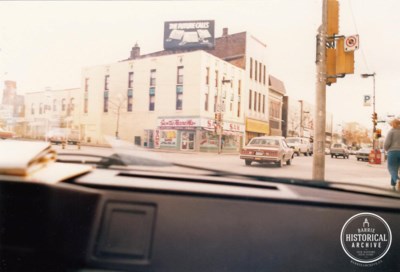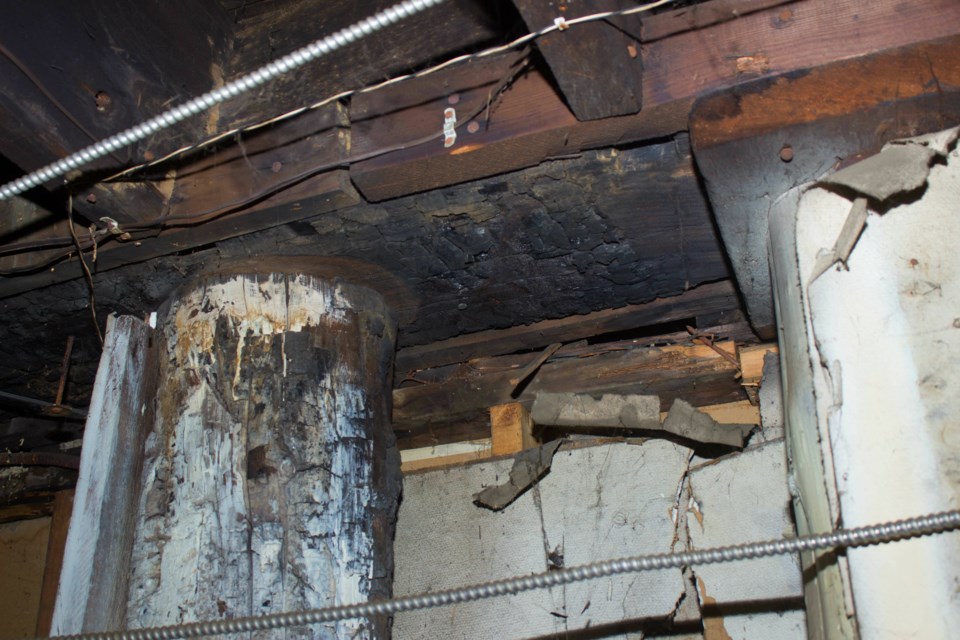I ran a hand over the blackened beams. My fingers were stained by the powdery charcoal as if I had just lifted a partially burned log out of a campfire.
The scorched wood was cool to the touch, as well it should be considering the fire that left its mark on these lengths of lumber happened on a February night in 1876.
When I arrived that day, it was mid afternoon and the regulars were ensconced in their favourite seats at the bar, warm and comfortable, enjoying beers and friendly conversation. The barroom looked modern, having only recently been extensively renovated in 2010, with newer walls, booths, lighting and pool tables, but this contemporary scene keeps very well the long history of this spot.
 Driving through Five Points looking at Sam The Record Man and Grandma Lee's. Circa 1985. Photo courtesy of Barrie Historical Archive.
Driving through Five Points looking at Sam The Record Man and Grandma Lee's. Circa 1985. Photo courtesy of Barrie Historical Archive. The floor that the patrons walk on is supported by the heavy beams hewn from the trees of local forests. These wooden supports were laid in place by craftsmen in 1853, and even though a devastating fire laid waste the entire hotel and stable above, the hardwood beams held fast even as the flames licked them and turned them black.
Roberta has been working at the Simcoe Hotel, in the bar and dining room known as the Bourbon, for two years now. She very graciously took a half an hour out of her time to lead me down into the cavernous cellar of the grand old Simcoe, rebuilt in 1877. We zigzagged through the kitchen area, up this step and down another, finally coming to a steep and narrow staircase with uneven cement steps, bordered by fieldstone walls and no rails.
I was excited already. If a person can physically get into the history of Barrie, being in the foundation of the iconic Simcoe Hotel must surely be it, and I was one very happy amateur local historian to have this privilege.
The original walls were amazingly straight. The passage of time has not shaken them any – not frost or fire, excavation of the streets, rumbling locomotives or seismic activity. They stand like new, just as they were when the masons placed the ordinary stones in mortar 164 years ago. A fine crust of a salt-like substance adheres to the rock in some places.
The centuries and decades are layered upon each other, it is plain to see here, with every new improvement requiring updated electrical, heating and ventilation conduits, and water pipes which snake over and under the older utilities. Old brick walls abut even older stone walls. Wooden partitions meet contemporary drywall. Some of the floor is cement, other parts are pure Barrie earth.
This cellar is no time capsule though, but a working part of the building containing the beer chute and storage, heating units, unused furnishings and what has to be the oldest working walk-in fridge in Barrie.
I started to pick up an ancient metal bucket, but it nearly crumbled in my hand. How long has this simple object tumbled around in the belly of the Simcoe? Was water tossed from it in a vain effort to save the old Simcoe Hotel? The Barrie Examiner of February 17, 1876 lauds the attempts of local bystanders who tried their best to quell the flames before the fire brigade arrived.
“At about 3 o’clock on Sunday morning last our townsfolk were startled from their slumbers by the loud clanging of the Fire Alarm Bell, when it was speedily ascertained that it was the stable of the Simcoe Hotel, situated on Bayfield and Clapperton Streets, that was in flames. In a few minutes after the alarm was given, the engine was ready for action, steam and all, but alas! no horses were forthcoming to draw it, which occasioned a loss of time that was irreparable.” In the end, the hotel and stable structures were lost, but a number of citizens, including a clergyman, had tried their best to save them.
“Prior to the arrival of the engine at the scene of action, the Rev. Mr. Fraser, Mr. Thos. Lennox, Mr. Hunt, Mr. Hughes and others did much to keep the fire in check by playing on the flames with a hand engine etc.”
I asked Roberta if she ever got lost down in this maze-like cellar, but she had quickly developed a ‘peanut trail’, as she called it, method of finding her way back out. A bit later, I put Roberta on the spot again. Had she ever experienced anything ghostly in the basement? She replied that nothing of note had ever happened to her, but she did feel that someone else was usually in the basement with her.
Before we returned to the daylight world, Roberta showed me where the moonshine had been made, in a low, well-drained anteroom. I believe most taverns in Barrie made their own liquor at one time or another, and that Prohibition times must have made the production of illicit hooch all the more necessary – very hard to run a bar with no drink!
Solid chunks of granite, sand and rugged, smoke-damaged timbers support the Simcoe just as well as they did sixteen decades ago, and show no sign of ever doing anything else.
This rustic looking foundation speaks volumes to the skill of the original craftsmen, to the tenacity of those who tried to save the earlier hotel building, to George Ball and company who hoisted a phoenix from literal ashes, and to Mr. Shanacy who persevered as a hotelier here even after that disaster.
The next time you find yourself in the Bourbon, be sure to raise a glass to all of them.
Each week, the Barrie Historical Archive provides BarrieToday readers with a glimpse of the city’s past. This unique column features photos and stories from years gone by and is sure to appeal to the historian in each of us.



